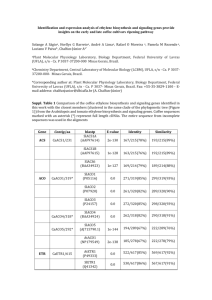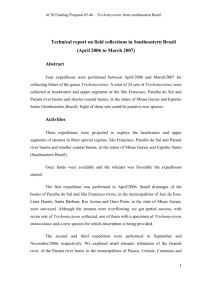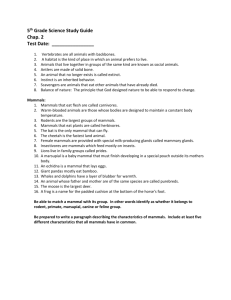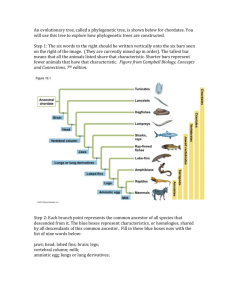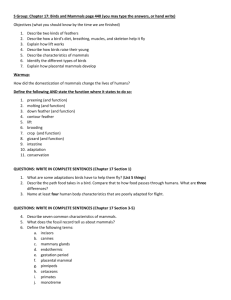Mammals, Volta Grande Environmental Unity, Triângulo Mineiro
advertisement
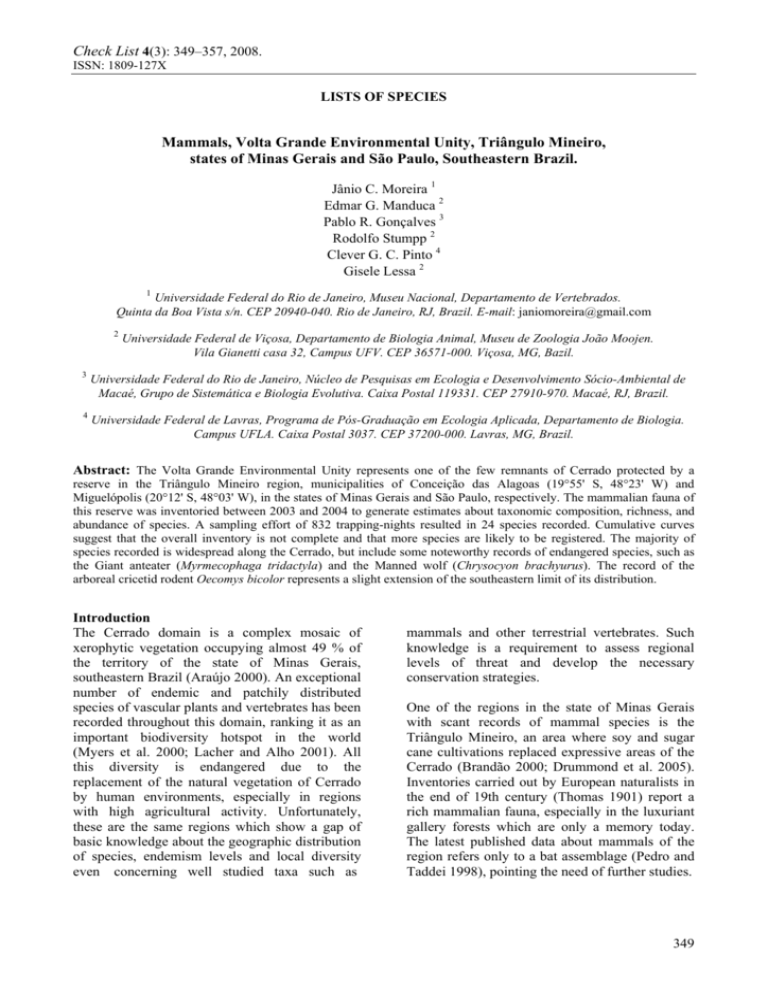
Check List 4(3): 349–357, 2008. ISSN: 1809-127X LISTS OF SPECIES Mammals, Volta Grande Environmental Unity, Triângulo Mineiro, states of Minas Gerais and São Paulo, Southeastern Brazil. Jânio C. Moreira 1 Edmar G. Manduca 2 Pablo R. Gonçalves 3 Rodolfo Stumpp 2 Clever G. C. Pinto 4 Gisele Lessa 2 1 Universidade Federal do Rio de Janeiro, Museu Nacional, Departamento de Vertebrados. Quinta da Boa Vista s/n. CEP 20940-040. Rio de Janeiro, RJ, Brazil. E-mail: janiomoreira@gmail.com 2 Universidade Federal de Viçosa, Departamento de Biologia Animal, Museu de Zoologia João Moojen. Vila Gianetti casa 32, Campus UFV. CEP 36571-000. Viçosa, MG, Bazil. 3 Universidade Federal do Rio de Janeiro, Núcleo de Pesquisas em Ecologia e Desenvolvimento Sócio-Ambiental de Macaé, Grupo de Sistemática e Biologia Evolutiva. Caixa Postal 119331. CEP 27910-970. Macaé, RJ, Brazil. 4 Universidade Federal de Lavras, Programa de Pós-Graduação em Ecologia Aplicada, Departamento de Biologia. Campus UFLA. Caixa Postal 3037. CEP 37200-000. Lavras, MG, Brazil. Abstract: The Volta Grande Environmental Unity represents one of the few remnants of Cerrado protected by a reserve in the Triângulo Mineiro region, municipalities of Conceição das Alagoas (19°55' S, 48°23' W) and Miguelópolis (20°12' S, 48°03' W), in the states of Minas Gerais and São Paulo, respectively. The mammalian fauna of this reserve was inventoried between 2003 and 2004 to generate estimates about taxonomic composition, richness, and abundance of species. A sampling effort of 832 trapping-nights resulted in 24 species recorded. Cumulative curves suggest that the overall inventory is not complete and that more species are likely to be registered. The majority of species recorded is widespread along the Cerrado, but include some noteworthy records of endangered species, such as the Giant anteater (Myrmecophaga tridactyla) and the Manned wolf (Chrysocyon brachyurus). The record of the arboreal cricetid rodent Oecomys bicolor represents a slight extension of the southeastern limit of its distribution. Introduction The Cerrado domain is a complex mosaic of xerophytic vegetation occupying almost 49 % of the territory of the state of Minas Gerais, southeastern Brazil (Araújo 2000). An exceptional number of endemic and patchily distributed species of vascular plants and vertebrates has been recorded throughout this domain, ranking it as an important biodiversity hotspot in the world (Myers et al. 2000; Lacher and Alho 2001). All this diversity is endangered due to the replacement of the natural vegetation of Cerrado by human environments, especially in regions with high agricultural activity. Unfortunately, these are the same regions which show a gap of basic knowledge about the geographic distribution of species, endemism levels and local diversity even concerning well studied taxa such as mammals and other terrestrial vertebrates. Such knowledge is a requirement to assess regional levels of threat and develop the necessary conservation strategies. One of the regions in the state of Minas Gerais with scant records of mammal species is the Triângulo Mineiro, an area where soy and sugar cane cultivations replaced expressive areas of the Cerrado (Brandão 2000; Drummond et al. 2005). Inventories carried out by European naturalists in the end of 19th century (Thomas 1901) report a rich mammalian fauna, especially in the luxuriant gallery forests which are only a memory today. The latest published data about mammals of the region refers only to a bat assemblage (Pedro and Taddei 1998), pointing the need of further studies. 349 Check List 4(3): 349–357, 2008. ISSN: 1809-127X LISTS OF SPECIES Here we report the results of a mammalian survey carried out from 2003 to 2004 in a reserve at the margins of the Grande River in the Triângulo Mineiro, the environmental unity of the Volta Grande Dam. This reserve is one of the few protected remnants of Cerrado in the Triângulo Mineiro, thus offering a good opportunity to investigate the richness and composition of Neotropical mammals surviving in the region. Material and methods Study site The environmental unity of Volta Grande encompasses the municipalities of Conceição das Alagoas (19°55' S, 48°23' W) and Miguelópolis (20°12' S, 48°03' W) in the states of Minas Gerais and São Paulo, respectively (Figure 1). It has an area of 391 ha and presents a climate Cwa of Koeppen system with a well defined dry season (May to October), with mean temperatures varying from 22º to 24º C. The annual mean rainfall is 1,550 mm (Filardi et al. 2007). The reserve was created in the late seventies after the construction of a hydro-electrical dam managed by the Companhia Energética do Estado de Minas Gerais (CEMIG). Since then, it has been used for wildlife management, conservation and fish farming, and research. Much of the original vegetation was altered during the implementation of the water reservoir, but typical Cerrado physiognomies can still be found in secondary regeneration, such as: 1) savannas with scattered shrubs (campo sujo); 2) open canopy woodland with a grassy, savanna understory (cerrado strictu senso); 3) dense, closed, and semi-closed canopy tall woodland (cerradão); and 4) moist gallery or riverine forests (mata ciliar) (Eiten 1972; Lacher and Alho 2001; Filardi et al. 2007). The reserve is divided by the Grande River, a major tributary of the Paraná River basin. Our surveys included sites localized in the states of São Paulo and Minas Gerais. _________________________________________________ Figure 1. Map (modified from Filardi et al. 2007) showing the location of Volta Grande Environmental Unity, southeastern Brazil, with a northern limit in the municipality of Conceição das Alagoas, state of Minas Gerais and to southern limit in the municipality of Miguelópolis, state of São Paulo. 1-3, sites where were established traplines for terrestrial small mammals collection; 4-6, sites where mist-nets for capture of bats were established; C, Cerradão; CSS, cerrado strictu senso; SM, Semidecidual Forest. 350 Check List 4(3): 349–357, 2008. ISSN: 1809-127X LISTS OF SPECIES Sampling methods Mammals exhibit a large variety of dietary strategies, ecological niches, and activity patterns. Therefore a diversified methodology was adopted in order to sample the most representative groups. The local fauna of the reserve was surveyed in two periods, the first one carried out in October 2003 and the last one in June 2004. License to collect specimens was provided by the Brazilian Institute of Environment and Natural Resources (IBAMA, process # 02022.004626-1999). Small terrestrial rodents and marsupials were sampled using 187 Sherman (9x9x23 and 9x9x31 cm) and 10 Tomahawk (15x15x31 cm) live traps. Five trap lines at least 100m apart were implemented as linear transects crossing three distinct habitats: campo sujo, mata ciliar, and cerrado strictu sensu. Each trap line had from 16 to 40 traps at least 20 m apart, which were set mostly on the ground near tree roots and fallen logs. Occasionally, some trapping stations were set above the ground tied to lianas, bamboos, and tree trunks 2-3 m high. Baits included banana, sardines, sunflower seed, and maize flour across 10 days of cumulated trapping, summing a sampling effort of 832 trap-nights. Bats were caught mainly using 3 mist nets (7-10 m), being only sporadically collected in roosting sites inside roofs and rarely inhabited houses. Nets were placed near potential roosts, feeding sources (fishing tanks, fruiting trees), forest clearings, and small water courses, remaining opened from 18:00 to 00:00 h and being checked every 20 min across 8 days of cumulated trapping, summing a sampling effort of 2,520 m2.h. Data on time of capture, sex, weigh, measurements, habitat of capture, reproductive condition, and parasites were registered for all rodents, marsupials, and bats. Selected specimens were prepared as standard vouchers and deposited in the collection of the Museu de Zoologia João Moojen, Universidade Federal de Viçosa, in the state of Minas Gerais (MZUFV) for the purposes of documentation and precise identification. Identification at the species level was guided by morphological comparisons with samples and published descriptions of confidently identified series from other localities deposited in Brazilian institutions (Museu Nacional/UFRJ). João A. Oliveira granted access to collections of the Museu Nacional for species identifications. For bats were used the taxonomic keys proposed by Vizotto and Taddei (1973) and Anderson (1997). Specimens representing species already vouchered in collections and of easy external identification had their biometrical, sex, and reproductive data registered and were released. Large and medium size mammals were surveyed through diurnal (06:30 – 08:00 h) and nocturnal sampling (17:30 – 00:00 h) along trails and roads crossing the reserve or near mist-netting points and trapping trails, summing 80 h of observations in the field. Direct observations were recorded by photos when possible and copies can be obtained from authors under request. Collection of carcasses and indirect signs, such as tracks, vocalizations, and feces were recorded by photos and preserved as voucher-material (carcasses, tracks). Field guides (Dalponte and Becker 1990; Emmons and Feer 1997; Pitman et al. 2002) were used to help identifications of specimens and tracks. A second source of information about large and medium sized mammals of the area came from interviews with local rangers familiarized with the local fauna. This type of register was, however, considered only as putative, pending future confirmation and documentation. The relative completeness of the inventory was assessed through the inspection of the topology of cumulative curves (Voss et al. 2001). The temporal entries of species count were randomized (rarefaction) in the software EstimateS (version 7.5, R. K. Colwell, http:// purl.oclc.org/estimates) to produce standardized accumulation curves, in which individual records were considered as the minimum grain (Hortal et al. 2006). Complete and more accurate inventories are expected to show asymptotic curves of species accumulation throughout fieldwork (Voss and Emmons 1996; Gotelli and Colwell 2001). 351 Check List 4(3): 349–357, 2008. ISSN: 1809-127X LISTS OF SPECIES Table 1. List of the twenty-four species recorded in the Volta Grande Environmental Unity. Order, family, record type, habitat, and state are showed for each species. C, Captured; CSS, cerrado strictu senso; I, Interview; MG, Minas Gerais; O, Observed; SM, Semidecidual Forest; SP, São Paulo; T, Track. Species recorded Order Didelphimorphia Gill, 1872 Family Didelphidae Gray, 1821 Didelphis albiventris Lund, 1840 Gracilinanus agilis (Burmeister, 1854) Order Cingulata Illiger, 1811 Family Dasypodidae Bonaparte, 1838 Dasypus novemcinctus Linnaeus, 1758 Order Pilosa Flower, 1883 Family Myrmecophagidae Gray, 1825 Myrmecophaga tridactyla Linnaeus, 1758 Order Primates Linnaeus, 1758 Family Cebidae Bonaparte, 1831 Callithrix penicillata (É. Geoffroy, 1812) Family Atelidae Gray, 1825 Alouatta caraya (Humboldt, 1812) Order Rodentia Bowdich, 1821 Family Cricetidae Fischer, 1817 Calomys tener (Winge, 1887) Necromys lasiurus (Lund, 1841) Oecomys bicolor (Tomes, 1860) Family Erethizontidae Bonaparte, 1845 Coendou prehensilis (Linnaeus, 1758) Family Dasyproctidae Bonaparte, 1838 Dasyprocta azarae Lichtenstein, 1823 Family Caviidae Gray, 1821 Hydrochoerus hydrochaeris (Linnaeus, 1766) Order Chiroptera Blumenbach, 1779 Family Molossidae Gervais, 1856 Molossus molossus (Pallas, 1766) Family Noctilionidae Gray, 1821 Noctilio albiventris Desmarest, 1818 Family Phyllostomidae Gray, 1825 Artibeus lituratus (Olfers, 1818) Artibeus jamaicensis (Spix, 1823) Artibeus obscurus Schinz, 1821 Carollia perspicillata (Linnaeus, 1758) Glossophaga soricina (Pallas, 1766) Platyrrhinus lineatus (Geoffroy, 1810) Family Vespertilionidae Gray, 1821 Eptesicus furinalis (D'Orbigny, 1847) Order Carnivora Bowdich, 1821 Family Canidae Fischer, 1817 Cerdocyon thous (Linnaeus, 1766) Chrysocyon brachyurus (Illiger, 1815) Order Artiodactyla Owen, 1848 Family Cervidae Goldfuss, 1820 Mazama gouazoubira (Fischer, 1814) State Record type Habitat C C SM SM I O SM X I O SM CSS X I O SM X I O SM X X C C C CSS CSS Cerradão SM X X I O SM X I O CSS SM X X O T SM X X MG SP X X X X C X C X C C C C C C X X X X X X C X I O I O T CSS SM CSS X X I O T CSS SM X X X 352 Check List 4(3): 349–357, 2008. ISSN: 1809-127X LISTS OF SPECIES Results and discussion The two trapping seasons in the Volta Grande unity resulted in the register of 24 species of mammals, two of them endangered, distributed in eight orders and fourteen families (Table 1). For a trapping effort of 832 trapping-nights employed to capture non-volant small mammals, we obtained a trapping success of 7.81 %. Bats of the families Molossidae, Noctilionidae, Phyllostomidae, and Vespertilionidae represented the majority of species (39 %), followed by rodents of the families Caviidae, Cricetidae, and Dasyproctidae, which were represented by six species (25 %). Order Chiroptera Nine species of bats were recorded in the Volta Grande Unity (Tables 1 and 2). The Fishing bat Noctilio albiventris was the most abundant bat species recorded during the surveys. Most captures took place near the fishing tanks at the margins of the Grande River, where groups of individuals usually flown during the first dusk hours. Bats of the family Phyllostomidae, although more diverse in species number were relatively rare throughout netting-nights. The Long-tongued bat Glossophaga soricina was the most abundant phyllostomid, being also captured inside houses and dormitories in the facilities of the reserve. Three large-sized species of Artibeus were recorded near fruiting trees at the same mistnetting point. The insectivorous molossid and vespertiolionid bats were unevenly recorded, with a few individuals captured near a roosting site inside a roof. All bat species registered have wide distributions throughout several South American biomes and have been reported by Pedro and Taddei (1998) for the region. Non-volant small mammals Orders Didelphimorphia and Rodentia The fauna of small mammals was represented in the Volta Grande Unity by two marsupials, Didelphis albiventris and Gracilinanus agilis, and three cricetid rodents, Calomys tener, Necromys lasiurus, and Oecomys bicolor (Tables 1 and 2). A preliminary review on distribution and structure of non-volant small mammals' assemblages in Cerrado revealed that marsupials are usually rare in this biome, with the exception of Didelphis and Gracilinanus (Vieira and Palma 2005). The White eared opossum, Didelphis albiventris, was the most common marsupial occupying remnants of Semidecidual forest and varzea, while the Gracile mouse opossum Gracilinanus agilis was found only on Semidecidual forests. _________________ Table 2. Number of individual captures, by state, for species of bats and terrestrial small mammals. MG, Minas Gerais; SP, São Paulo. Species Artibeus jamaicensis Artibeus lituratus Artibeus obscurus Calomys tener Carollia perspicillata Didelphis albiventris Eptesicus furinalis Glossophaga soricina Gracilinanus agilis Molossus molossus Necromys lasiurus Noctilio albiventris Oecomys bicolor Platyrrhinus lineatus Total State MG SP 2 1 3 1 2 3 1 1 15 1 3 11 20 1 10 1 61 15 Total 2 1 3 3 3 1 1 15 1 3 11 21 10 1 76 The cricetid rodents Necromys lasiurus and Calomys tener occurred mostly on more open habitats of cerradão, campo sujo, and cerrado sensu stricto. In contrast, the arboreal cricetid Oecomys bicolor was found exclusively in forested habitats. Despite the common occurrence of Oecomys bicolor in the Cerrado and Amazonia (Hershkovitz 1960), there are few records of this species from Minas Gerais (Carmignotto 2004). The present record represents a slight extension of its southeastern limit of distribution, in as much as all captures occurred at the São Paulo side of the reserve (municipality of Miguelópolis). Order Primates Groups of the Black-tufted-ear marmoset, Callithrix penicillata, were seen in fruiting trees along the reserve. This species is a common component of the mastofauna of the Caatinga and Cerrado biomes (Bicca-Marques et al. 2006). We 353 Check List 4(3): 349–357, 2008. ISSN: 1809-127X LISTS OF SPECIES also heard the vocalization of the Black howler monkey, Alouatta caraya, in a neighbor remnant. In addition to the reports of reserve rangers and employees, the presence of this species was later confirmed visually by one of the authors in a short-visit after the sampling periods. Medium to large mammals Among large and medium sized mammals, Armadillo (Dasypus novemcinctus), Agouti (Dasyprocta azarae), and Capybara (Hydrochoerus hydrochaeris) were the most frequently registered species, seen directly or by tracks. Individuals of the Brocket deer (Mazama gouazoubira) were also recorded by direct observation (Figure 2) and tracks. The individuals observed presented grayish-brown neck and dorsum which becomes paler at the laterals and venter. The identification of the specimens was based on the relatively large and rounded ears and smaller size as judged by their tracks (Tiepolo and Tomas 2006). The presence of the Giant anteater Myrmecophaga tridactyla reported by the local rangers and reserve employees was confirmed by nocturnal observations near the dam (Table 1). Carnivores were the rarest mammals recorded. A couple of Crab-eating foxes (Cerdocyon thous) was seen crossing the limits of the reserve and tracks of the Manned wolf (Chrysocyon brachyurus) could be identified along trails. In addition, the presence of this latter canid was recurrently reported by the reserve rangers and employees at both sides of the reserve. Figure 2. Some mammals recorded in the Volta Grande Environmental Unity, on samples made between 2003 and 2004. A, tracks of Mazama gouazoubira; B, individual of Mazama gouazoubira; C, tracks of Hydrochoerus hydrochaeris; D, Hydrochoerus hydrochaeris; E, Molossus molossus; F, Callithrix penicillata; G, Glossophaga soricina; H, Artibeus lituratus; I, Platyrrhinus lineatus; J, Noctilio albiventris; K, Coendou prehensilis. Referential scale figured in tracks photos are of approximately 15 cm. 354 Check List 4(3): 349–357, 2008. ISSN: 1809-127X LISTS OF SPECIES Comparisons The diversity recorded in the Environmental Unity of Volta Grande Dam is lower than other Cerrado sites in central Brazil, such as the Emas National Park, state of Goiás, that shows a richness of 85 species (Rodrigues et al. 2002) and the Serra das Araras Biological Station, state of Mato Grosso, with 50 species (Santos-Filho and Silva 2002; Carmignotto 2004; Gonçalves and Gregorin 2004). These sites, however, have a larger area than the Volta Grande Unity and the inventories carried out in these remnants were based on a longer and more intensive sampling-effort. The topology of the species accumulation curves constructed on the basis of our captures (Figure 3) does not show an asymptotic tendency, indicating that the inventory is not complete, especially for bats (Voss and Emmons 1996). Additional fieldwork with combination of different sampling methodologies may result in the record of more species. The inventory of bats carried out by Pedro and Taddei (1998) and the present study are preliminary assessments, but represent a relevant contribution to fill the knowledge gap about the mammalian fauna of the Triângulo Mineiro region. As incomplete as this knowledge is, our limited sampling already revealed new or relevant records, such as the Arboreal mouse (Oecomys bicolor), the Giant anteater (Myrmecophaga tridactyla), and the Manned wolf (Chrysocyon brachyurus), the later two classified as vulnerable by the most recent Brazilian list of endangered species (IBAMA 2003). Considering the absence of official reserves at the Triângulo Mineiro (Drummond et al. 2005) these records highlights the importance of the Volta Grande Unity as a conservation unit in the area. Nevertheless, major assessments and additional trapping in the Cerrado of southwestern Minas Gerais are deemed critical to elucidate the effects of intensive habitat loss in this biome at the expense of extensive agriculture activity in this region. Figure 3. Mammal species accumulation curve for volant and terrestrial small mammals surveyed in Volta Grande Environmental Unity, considering the increasing number of individual captures. 355 Check List 4(3): 349–357, 2008. ISSN: 1809-127X LISTS OF SPECIES Acknowledgements We are grateful to Dr. Renato Feio and to SIF/CEMIG that provided us essential logistical support during field trips. The helpful and constructive suggestions of two anonymous reviewers helped us to improve the manuscript. CEMIG and SIF granted financial support. Literature cited Anderson, S. 1997. Mammals of Bolivia, taxonomy and distribution. Bulletin of the American Museum Natural History 231:1-652. Araújo, M. A. R. 2000. Conservação da biodiversidade em Minas Gerais: em busca de uma estratégia para o século XXI. Belo Horizonte: Unicentro Newton Paiva. 36 p. Bicca-Marques, J. C., V. M. Silva, and D. F. Gomes. 2006. Ordem Primates; p. 101-148 In N. R. Reis, A. L. Peracchi, W. A. Pedro, and I. P. Lima (ed.). Mamíferos do Brasil. Londrina: Universidade Estadual de Londrina. Brandão, M. 2000. Caatinga; p. 75-85 In M. P. Mendonça and L. V. Lins (ed.). Lista vermelha das espécies ameaçadas de extinção da flora de Minas Gerais. Belo Horizonte: Fundação Biodiversitas and Fundação ZooBotânica de Belo Horizonte. Câmara, T. and R. Murta. 2003. Mamíferos da Serra do Cipó. Belo Horizonte: PUCMinas, Museu de Ciências Naturais. 129 p. Carmignotto, A. P. 2004. Pequenos mamíferos do bioma Cerrado: padrões faunísticos locais e regionais. São Paulo: Universidade de São Paulo. Doctoral Thesis. 383 p. Dalponte, J. C and M. Becker. 1991. Rastros de mamíferos silvestres brasileiros. Brasília: Editora UnB. 180 p. Drummond, G. M., C. S. Martins, A. B. M. Machado, F. A. Sebaio, and Y. Antonini. 2005. Biodiversidade em Minas Gerais: um atlas para sua conservação. Belo Horizonte: Fundação Biodiversitas. 222 p. Eiten, G. 1972. The cerrado vegetation of Brazil. Botanical Review 38: 201-341. Emmons, L. H. and F. Feer. 1997. Neotropical rainforest mammals – A field guide. Chicago: The University of Chicago Press. 281 p. Filardi, F. L. R., F. C. P. Garcia, and R. M. CarvalhoOkano. 2007. Espécies lenhosas de Papilionoideae (Leguminosae) na Estação Ambiental de Volta Grande, Minas Gerais, Brasil. Rodriguésia 58(2): 363-378. Gonçalves, E. and R. Gregorin. 2004. Quirópteros da Estação Ecológica da Serra das Araras, Mato Grosso, Brasil, com o primeiro registro de Artibeus gnomus e A. anderseni para o cerrado. Lundiana 5(2): 143-149. Gotelli, N. J. and R. K. Colwell. 2001. Quantifying biodiversity: procedures and pitfalls in the measurement and comparison of species richness. Ecology Letters 4: 379-391. Hershkovitz, P. 1960. Mammals of Northern Colombia, Preliminary 8: Arboreal rice rats, a systematic revision of the subgenus Oecomys, genus Oryzomys. Proceedings of the United States National Museum 110: 535–539. Hortal, J., P. A. V. Borges, and C. Gaspar. 2006. Evaluating the performance of species richness estimators: Sensivity to sample grain size. Journal of Animal Ecology 75: 274-287. IBAMA. Instituto Brasileiro do Meio Ambiente e dos Recursos Naturais Renováveis. 2003. Lista Nacional das Espécies da Fauna Brasileira Ameaçadas de Extinção. Eletronic database accessible at http://www.mma.gov.br/port/sbf/fauna/index.cfm. Captured on January 2008. Lacher, T. E. and C. J. R. Alho. 2001. Terrestrial small mammal richness and habitat associations in an Amazon Forest-Cerrado contact zone. Biotropica 33(1): 171-181. Moojen, J. 1943. Captura e preparação de pequenos mamíferos para coleções de estudo. Rio de Janeiro: Imprensa Nacional. 100 p. Myers, N., R. A Mittermeier, C. G Mittermeier, G. A. B. Fonseca, and J. Kent. 2000. Biodiversity hotspots for conservation priorities. Nature 403: 853-858. Musser, G. G. and M. D. Carleton. 2005. Superfamily Muroidea; p. 894-1531 In D. E. Wilson and D. M. Reeder (ed.). Mammals species of the world, a taxonomic and geographic reference. Volume 2. 3rd edition. Baltimore: The John Hopkins University Press. Oliveira, T. G. and K. Cassaro 1999. Guia de identificação dos felinos brasileiros. 2a edição. São Paulo: Sociedade de Zoológicos do Brasil. 60 p. Pedro, W. A. and V. A. Taddei. 1998. Bats from Southwestern Minas Gerais, Brazil (Mammalia: Chiroptera). Chiroptera Neotropical 4(1): 85-88. Pitman, M. R. P. L., T. G. Oliveira, R. C. Paula, and C. Indrusiak. 2002. Manual de identificação, prevenção e controle de predação por carnívoros. Brasília: Edições IBAMA. 83 p. 356 Check List 4(3): 349–357, 2008. ISSN: 1809-127X LISTS OF SPECIES Rodrigues, F. H. G., L. Silveira, A. T. Jácomo, A. P. Carmignotto, A. M. R. Bezerra, D. C. Coelho, H. Garbogini, J. Pagnozzi, and A. Hass. 2002. Composição e caracterização da fauna de mamíferos do Parque Nacional das Emas, Goiás. Revista Brasileira de Zoologia 19(2): 589-600. Santos-Filho, M. and M. N. F. Silva. 2002. Uso de habitats por mamíferos em área de Cerrado do Brasil Central: um estudo com armadilhas fotográficas. Revista Brasileira de Zoociências 4(1): 45-56 Thomas, O. 1901. On mammals obtained by Mr. Alphonse Robert on the Rio Jordão, S.W. Minas Gerais. Annals and Magazine of Natural History 9(8): 526-536. Tiepolo, L. M. and W. M. Tomas. 2006. Ordem Artiodactyla; p. 278-298 In N. R. Reis, A. L. Peracchi, W. A. Pedro, and I. P. Lima (ed.). Mamíferos do Brasil. Londrina: Universidade Estadual de Londrina. Vieira, E. M. and A. R. T. Palma. 2005. Pequenos mamíferos de Cerrado: distribuição dos gêneros e estrutura das comunidades nos diferentes habitats; p. 265-282 In A. Scariot, J. C. Sousa-Silva, and J.M. Felfili (org.). Cerrado: ecologia, biodiversidade e conservação. Brasília: Ministério do Meio Ambiente. Vizotto, L. D. and V. A. Taddei. 1973. Chave para identificação de quirópteros brasileiros. São José do Rio Preto; Faculdade de Filosofia, Ciências e Letras. 72 p. Voss, R. S. and L. H. Emmons. 1996. Mammalian diversity in Neotropical lowland rainforests: a preliminary assessment. Bulletin of the American Museum of Natural History 230: 1-115. Voss, R. S., D. P. Lunde, and N. C. Simmons. 2001. The mammals of Paracou, French Guiana: a Neotropical lowland rainforest fauna part 2. Nonvolant species. Bulletin of the American Museum of Natural History 263: 1-236. Received January 2008 Accepted July 2008 Published online September 2008 __________________________________________ Appendix 1 Voucher list: Didelphis albiventris (MZUFV 1942); Gracilinanus agilis (MZUFV 1364); Calomys tener (MZUFV 1311 and 1356); Necromys lasiurus (MZUFV 1310, 1314, 1354-5, 1357, and 1360-1); Oecomys bicolor (MZUFV 1312-6, 1358-9, and 1362-3); Hydrochoerus hydrochaeris (MZUFV 1770); Molossus molossus (MZUFV 1751-2 and 1760); Noctilio albiventris (MZUFV 1731-48, 1753-4, 1758, and 1850-1); Artibeus lituratus (MZUFV 1749); Artibeus jamaicensis (MZUFV 1755 and 1764); Artibeus obscurus (MZUFV 1756, 1763, and 1765); Carollia perspicillata (MZUFV 1757, 1759, and 1761); Glossophaga soricina (MZUFV 1716-30); and Eptesicus furinalis (MZUFV 1762). 357
